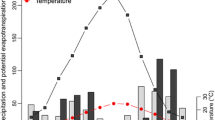Summary
The rate of consumption of dandelion leaves per g earthworm dry weight per week was described by non-linear functions of soil temperature, soil water potential, and food availability. The optimum temperature and soil water potential for food consumption are about 22°C and-7 kPa, respectively. Zero consumption occurred at about-40 kPa. Food consumption increased with greater food availability, but only up to 1.05 (dandelion) and 1.23 (grass) g dry weight per g earthworm dry weight per week at 15°C. A general consumption function to account for all three environmental factors is given. The assimilation rate per g earthworm dry weight per week was defined as the sum of the growth rate and the maintenance rate. Maintenance was calculated according to respiratory measurements reported previously, whereas growth was measured. High temperatures and limiting environmental conditions, such as a low food availability and a low soil water potential, led to an increase in the assimilation efficiency of Lumbricus terrestris. At-7 kPa and 15°C, L. terrestris assimilated 55 and 43% of the ingested dandelion if 0.25 and 1.0 g dry weight of food was available per g earthworm dry weight per week, respectively. it is concluded that L. terrestris has a strong, direct effect on the decomposition of highly palatable plant materials.
Similar content being viewed by others
References
Anderson JM (1988) Spatiotemporal effects of invertebrates on soil processes. Biol Fertil Soils 6:216–227
Beven K, Germann P (1982) Macropores and water flow in soils. Water Resour Res 8:1311–1325
Bolton PJ, Philipson J (1976a) Energy equivalents of earthworms, their egesta and a mineral soil. Pedobiologia 16:443–450
Bolton PJ, Phillipson J (1976b) Burrowing, feeding, egestion and energy budgets of Allolobophora rosea (Savigny) (Lumbricidae). Oecologia (Berlin) 23:225–245
Byzova JB (1965) Comparative rate of respiration in some earthworms (Lumbricidae, Oligochaeta). Rev Ecol Biol Sol 2:207–216
Carley WW (1978) Water economy of the earthworm Lumbricus terrestris L.: Coping with the terrestrial environment. J Exp Zool 205:71–78
Curry JP Bolger T (1984) Growth, reproduction and litter and soil consumption by Lumbricus terrestris L. in reclaimed peat. Soil Biol Biochem 16:253–257
Czihak G, Langer H, Ziegler H (1976) Biologie, Springer-Verlag, Berlin
Daniel O (1992) Population dynamics of Lumbricus terrestris L. (Oligochaeta, Lumbricidae) in a meadow. Soil Biol Biochem (in press)
Daniel O, Jager P, Cuendet G, Bieri M (1992) Sampling of Lumbricus terrestris L. (Oligochaeta, Lumbricidae). Pedobiologia (in press)
Dickschen F, Topp W (1987) Feeding activities and assimilation efficiencies of Lumbricus rubellus (Lumbricidae) on a plant-only diet. Pedobiologia 30:31–37
Kollmannsperger F (1955) Über Rhytmen bei Lumbriciden. Decheniana 108:81–92
Kretzschmar A (1989) Galeries de lombriciens en réseaux: Structures fonctionnelles et signatures comportementales. Ph. D. dissertation, University of Paris-Sud, Centre d'Orsay
Kudrjaševa IV (1982) Ves doždevych červej v svjazi s gidrologičeskimi uslovijami počvy. Pedobiologia 23:234–243
Kudrjaseva IV (1987) Seasonal changes in weight and body water content in the earthworm Eisenia nordenskioeldi (Eisen) (Oligochaeta, Lumbricidae). In: Striganova BR (ed) Soil fauna and soil fertility. Proc 9th Int Coll Soil Zool, Moscow Nauka, Moscow, pp 135–138
Laing JE, Heraty JM, Corrigan JE (1986) Leaf burial by earthworm, Lumbricus terrestris (Oligochaeta: Lumbricidae), as a major factor in the population dynamics of Phyllonorycter blancardella (Lepidoptera: Gracillariidae) and its parasites. Environ Entomol 15:321–326
Lavelle P (1974) Les vers de terre de la savane de Lamto. In: Analyse d'un écosystème tropical humide: La savane dç Lamto (Cote d'Ivoire). Bull Liaison Chercheurs Lamto, No Spéc 5:133–136
Lee KE (1985) Earthworms; Their ecology and relationships with solis and land use. Academic Press, Sydney
Petersen H, Luxton M (1982) A comparative analysis of soil fauna populations and their role in decomposition processes. Oikos 39:288–388
Pomerat CM, Zarrow MX (1936) The effect of temperature on the respiration of the earthworm. Proc Natl Acad Sci USA 22:270–272
Raw F (1962) Studies of earthworm populations in orchards I. Leaf burial in apple orchards. Ann Appl Biol 50:389–404
Satchell JE (1983) Earthworm ecology in forest soils. In: Satchell JE (ed) Earthworm ecology; From Darwin to vermiculture. Chapman and Hall, London, pp 161–177
Satchell JE, Lowe DG (1967) Selection of leaf litter by Lumbricus terrestris. In: Graff O, Stachell JE (eds) Progress in soil biology. North Holland Publishing Company, Amsterdam, pp 102–109
Shipitalo MJ, Protz R, Tomlin AD (1988) Effect of diet on the feeding and casting activity of Lumbricus terrestris and L. rubellus in laboratory culture. Soil Biol Biochem 20:233–237
Swift MJ, Heal OW, Anderson JM (1979) Decomposition in terrestrial ecosystems. Studies in Ecology 5, Blackwell Sci Publ, Oxford
Theng BKG, Tate KR, Sollins P (1989) Constituents of organic matter in temperate and tropical soils. In: Coleman DC, Oades JM, Uehara G (eds) Dynamics of soil organic matter in tropical ecosystems. Niftal Project, Hawaii, pp 5–32
Wolf AV (1938) Notes on the effect of heat in Lumbricus terrestris L. Ecology 19:346–348
Zar JH (1984) Biostatistical analysis. Prentice Hall, Englewood Cliffs, New Jersey
Zicsi A (1983) Earthworm ecology in deciduous forests in central and southeast Europe. In: Satchell JE (ed) Earthworm ecology. Chapman and Hall, London, pp 171–177
Zicsi A, Pobozsny M (1977) Einfluß der Streuzersetzungsverlaufes der Laubstreu auf die Konsumintensität einiger Lubriciden-Arten. In: Doeksen J, Drift van der J (eds) Soil organisms. North Holland Publishing Company, Amsterdam, pp 229–239
Author information
Authors and Affiliations
Rights and permissions
About this article
Cite this article
Daniel, O. Leaf-litter consumption and assimilation by juveniles of Lumbricus terrestris L. (Oligochaeta, Lumbricidae) under different environmental conditions. Biol Fertil Soils 12, 202–208 (1991). https://doi.org/10.1007/BF00337203
Received:
Issue Date:
DOI: https://doi.org/10.1007/BF00337203




